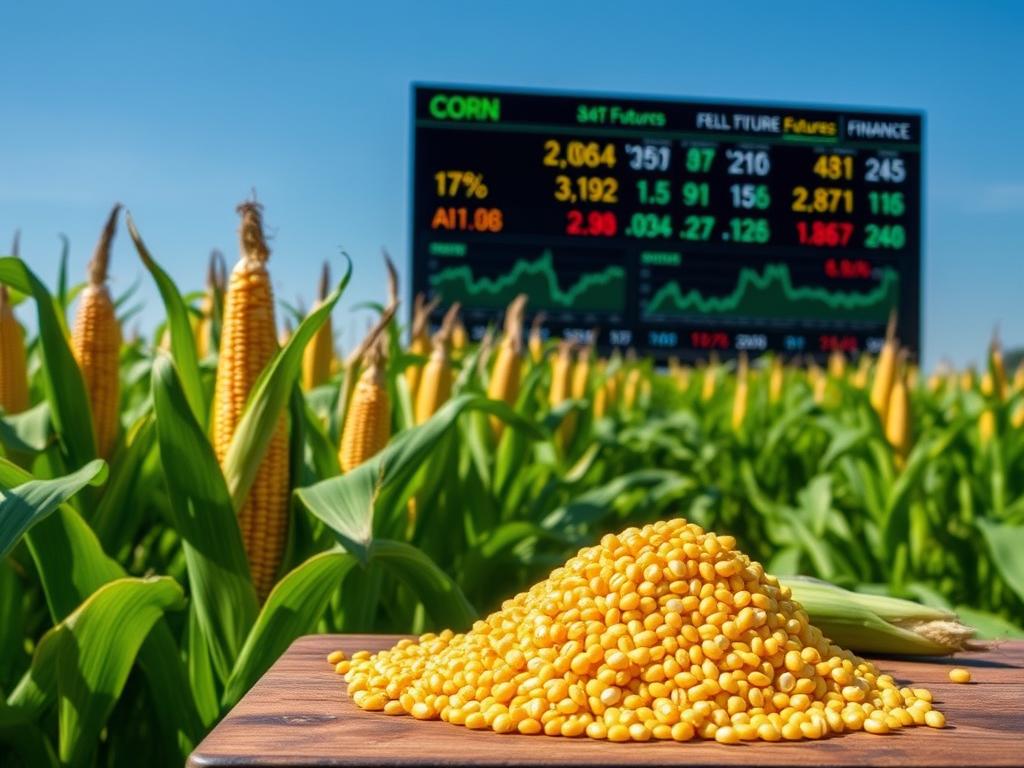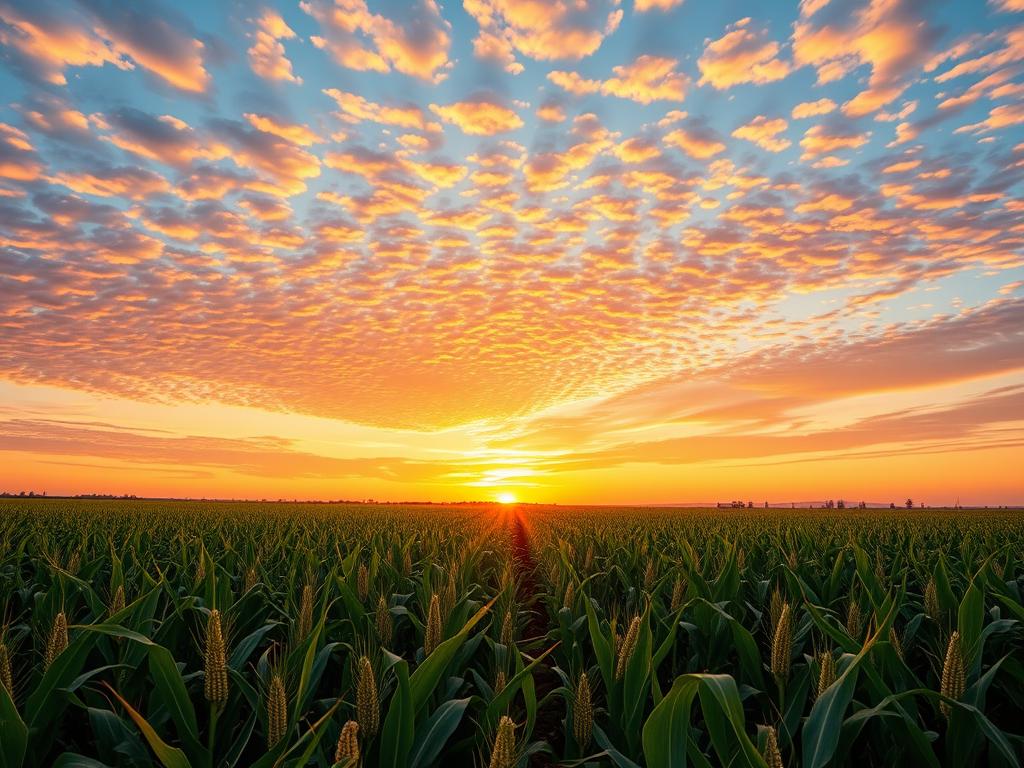FPO corn is key in the global agricultural economy. It’s a vital part of the agricultural futures markets. This affects food supply, trading, and investments.
This article dives into the world of FPO corn. We’ll look at its definition, history, and how futures markets influence its prices.
What is FPO Corn?
FPO corn, or forward physical option corn, is a type of corn futures contract. It’s traded on agricultural commodities exchanges. These contracts promise the future delivery of a certain amount and quality of corn at a set price and place.
The FPO corn market has a long history. It’s key for finding prices and managing risks for those who grow, process, and use corn.
Definition and Significance
FPO corn contracts are financial tools for buying or selling corn for future delivery. They help in finding prices and let people manage risks. This is important for those in the corn business.
The FPO corn market is vital in the agricultural world. It helps corn move smoothly from farmers to those who need it.
Historical Background
The FPO corn market started in the late 19th century in the United States. Early exchanges like the Chicago Board of Trade began trading corn and other farm products. Since then, the market has grown and changed with new technology and market needs.

“The FPO corn market has played a crucial role in price discovery and risk management for the corn industry, connecting producers, processors, and consumers in a dynamic marketplace.”
How FPO Corn Futures Markets Work
The FPO corn futures market is a place where people trade contracts for corn to be delivered later. Prices change based on how much corn is available and how much people want to buy. This reflects what everyone thinks will happen with corn in the future.
Many different people are involved in the FPO corn futures market. Each has their own reasons for being there:
- Producers – Farmers and suppliers who want to protect themselves from price changes. They aim to get a fixed price for their corn.
- Processors – Companies that turn corn into food and industrial products. They use the futures market to set prices and control costs.
- Traders – People or companies that buy and sell corn futures contracts. They try to make money from price changes.
- Speculators – Investors who don’t directly deal with corn but trade futures to make money from price swings.
In the FPO corn futures market, standardized contracts are traded. These contracts outline how much corn, its quality, and when it will be delivered. Prices change all day as supply and demand balance out.
The price discovery process is key in the FPO corn futures market. It sets a price that many in the agricultural world use. This process helps allocate corn efficiently and manage risks for both producers and consumers.
| Key Factors Influencing FPO Corn Futures Prices | Description |
|---|---|
| Supply and Demand Dynamics | Expectations about future corn production, consumption, and global trade patterns. |
| Weather Conditions | The impact of drought, floods, and other climatic factors on corn yields. |
| Government Policies | Subsidies, tariffs, and regulations that affect the corn market. |
| Geopolitical Tensions | Conflicts or trade disputes that disrupt global corn supply chains. |
“The FPO corn futures market is a critical mechanism for price discovery and risk management in the agricultural sector, connecting producers, processors, and investors from around the world.”
Key Players in FPO Corn Futures
The FPO corn futures market is full of different players. Each has their own goals and ways of doing things. Producers, suppliers, traders, and speculators all play big roles in how the market moves.
Producers and Suppliers
Farmers, grain elevators, and other producers and suppliers are key in the FPO corn futures market. They use futures to manage their risks. By selling futures, they lock in a price for their corn, keeping their finances stable.
Traders and Speculators
Traders, like companies and banks, also shape the market. They trade to make money from price changes. Speculators, who don’t own corn, try to make money from market ups and downs.
| Participant | Objective | Strategies |
|---|---|---|
| Producers and Suppliers | Hedge price risk, lock in profits | Selling corn futures contracts |
| Traders | Profit from price movements | Hedging, speculative trading |
| Speculators | Capitalize on market volatility | Speculative trading |
The mix of these players affects the FP.O corn futures market. It influences prices, how easy it is to trade, and the market’s stability.
“The FPO corn futures market is a complex and interconnected system, where the actions of producers, suppliers, traders, and speculators all contribute to the overall market landscape.”
Factors Affecting FPO Corn Prices
FPO corn futures prices are shaped by many factors. It’s important to understand these factors. This helps traders make smart choices and manage risks.
Supply and Demand Dynamics
The main drivers of FPO corn prices are supply and demand. Weather, crop yields, government policies, and global trends all play a role. These factors cause prices to change in the futures markets.
For example, bad weather can lower corn yields. This leads to a shortage and higher prices. Changes in government policies can also affect demand. This changes corn prices.
| Factors Influencing Corn Prices | Impact on Supply and Demand | Effect on Futures Prices |
|---|---|---|
| Weather Conditions | Crop Yields | Increased Volatility |
| Government Policies | Trade Regulations, Subsidies | Shifts in Demand |
| Global Economic Trends | Biofuel Demand, Livestock Production | Price Fluctuations |
Knowing what affects corn prices helps traders. They can better handle supply and demand in agricultural commodities. And they can deal with price fluctuations in futures markets.
“Analyzing the complex interplay of supply and demand factors is crucial for informed decision-making in the FP.O corn futures market.”
FPO Corn Futures Trading Strategies
Understanding the FPO corn futures market is key. Traders use many strategies to make money and manage risks. They look at market trends and try to predict price changes.
Hedging is a common strategy. It helps producers, suppliers, and users by locking in prices. This way, they can avoid big price swings and keep their costs or revenues steady.
Speculators, however, focus on making money from market ups and downs. They study trends and economic signs to find good trading opportunities.
- Spread trading is another tactic. It involves buying and selling different corn futures contracts. This can help diversify a portfolio and make money from price differences.
- Arbitrage is about finding and using price gaps in different markets. It helps make markets more efficient.
Good traders know how to manage risks in the commodity market. They use different strategies to deal with the challenges of the agricultural market. This can improve their trading results.
“Diversifying your portfolio with FP.O corn futures can provide a valuable hedge against market volatility and help stabilize your overall investment returns.”
It’s important to know the risks and how the FP.O corn futures market works. Traders and investors need to stay informed and make smart choices. This is key to success in the volatile world of agricultural commodities.
Risks and Challenges in FPO Corn Futures
The FPO corn futures market faces risks in corn futures trading and challenges. Volatility in agricultural markets can cause big price swings. The regulatory environment for commodity markets also changes, offering both chances and hurdles for traders and investors.
Market Volatility
The FPO corn futures market is very sensitive to weather, politics, and supply and demand changes. These factors can lead to quick and big price changes. It’s hard for traders to keep up. They need good risk management to deal with volatility in agricultural markets.
Regulatory Concerns
The rules around the FP.O corn futures market are complex and always changing. Following regulatory requirements and keeping up with new rules is tough. To stay ahead, traders must pay close attention and take proactive steps to comply.
| Risk Factor | Impact on FPO Corn Futures | Mitigation Strategies |
|---|---|---|
| Market Volatility | Sudden price fluctuations, increased risk for traders | Diversification, hedging, risk management techniques |
| Regulatory Concerns | Compliance challenges, adapting to new policies | Staying informed, working with regulatory authorities, implementing robust compliance processes |
By tackling these risks in corn futures trading, traders can do better in the FP.O corn futures market. This helps them succeed in the long run.
“Effective risk management is the cornerstone of successful FP.O corn futures trading in an increasingly volatile and regulated market.”
FPO Corn Futures and Global Food Security
The FPO corn futures market is key to global food security. It helps find prices and manage risks for corn producers and buyers. This ensures corn is supplied reliably and efficiently.
Corn is a main food for millions worldwide. Its price and availability are crucial for food security. The FPO corn futures market helps stabilize prices and supply, even with disruptions or demand changes.
This market also gives insights into corn supply and demand. Policymakers and aid groups use this info to improve food security in needy areas. They can plan better for food crises, ensuring everyone has access to affordable, nutritious corn-based foods.
In short, the FP.O corn futures market is vital for global food security. It helps keep corn prices stable and supply efficient. This supports food affordability and access, benefiting communities worldwide.
As the world faces the challenge of feeding more people, the FP.O corn futures market is crucial. Understanding this market helps make informed decisions and policies. These focus on making corn available, accessible, and affordable for all.
The Future of FPO Corn Futures Markets
The future of the FP.O corn futures market is set to see big changes. Technological innovations, new consumer tastes, and changes in global trade will shape it. Knowing these trends is key for those in the market to stay ahead.
Technology will play a bigger role in the FPO cor.n futures market. New platforms and tools will make trading faster and more transparent. Blockchain and AI could change how we track and trade FP.O corn, leading to more innovation.
Changes in what people eat and want will also affect FP.O corn demand. As people care more about the environment, demand for green and fair products will grow. Market players need to adapt to these changes to stay competitive.

